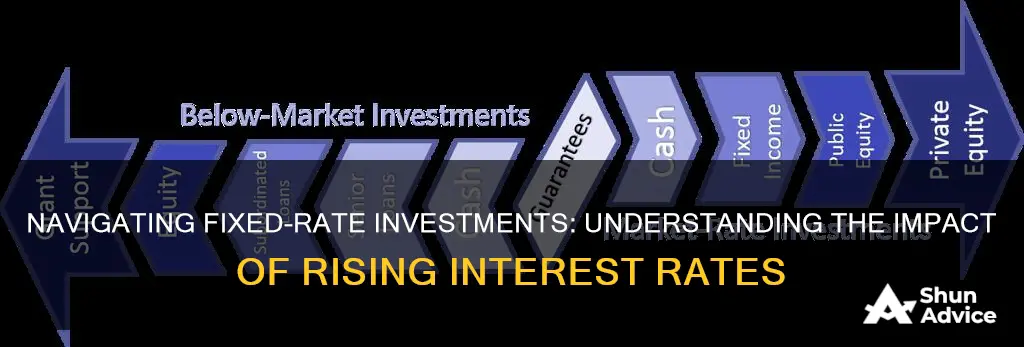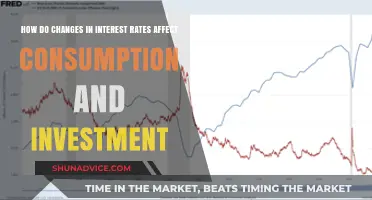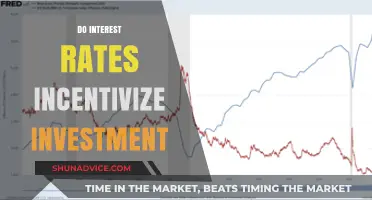
Rising interest rates can significantly impact fixed-rate investments, creating both opportunities and challenges for investors. When central banks increase interest rates, it typically leads to higher yields on fixed-income securities, such as bonds. This can be advantageous for fixed-rate investments, as the returns on these investments may increase in line with the rising interest rates. However, it's important to consider the potential drawbacks. As interest rates rise, the value of existing fixed-rate investments may decrease, especially if they offer lower yields compared to the new market rates. Investors need to carefully evaluate their investment strategies and consider the potential impact on their portfolios when navigating these market shifts.
What You'll Learn
- Impact on Bond Prices: Rising rates decrease bond prices, affecting fixed-rate investments like bonds
- Reduced Investment Appeal: Higher interest rates may discourage investors from fixed-rate investments due to lower returns
- Market Volatility: Interest rate hikes can lead to market volatility, impacting fixed-rate investment performance
- Long-Term vs. Short-Term: Fixed-rate investments may be more resilient in the long term despite short-term rate fluctuations
- Economic Indicators: Rising rates often signal economic growth, which can indirectly affect fixed-rate investment strategies

Impact on Bond Prices: Rising rates decrease bond prices, affecting fixed-rate investments like bonds
When interest rates rise, it has a direct and significant impact on the prices of existing bonds, particularly those with fixed rates. This is a crucial concept for investors to understand, especially those holding fixed-rate investments like bonds. As central banks adjust monetary policy to control inflation, the relationship between interest rates and bond prices becomes a critical factor in investment decisions.
Bonds are essentially loans made by investors to governments or corporations. When you buy a bond, you are essentially lending money to the issuer, who promises to pay you back the principal amount plus interest at a specified date. The interest rate on a bond is the return an investor can expect for lending their money. When interest rates rise, the market demand for new bonds with higher yields increases, which directly affects the price of existing bonds.
As interest rates increase, new bonds issued in the market will offer higher yields to attract investors. This makes older bonds with lower fixed rates less attractive, as investors can now find more profitable alternatives. As a result, the prices of these older bonds tend to decrease. For example, if a 10-year bond with a 3% fixed rate is now competing with new 10-year bonds offering 5% interest, the original bond's price will likely drop to reflect the lower relative value.
This decrease in bond prices can significantly impact fixed-rate investments. Investors who hold these bonds until maturity will still receive the original fixed rate of interest, but the value of their investment will be lower due to the decreased bond price. This effect is particularly relevant for long-term fixed-rate investments, as the impact of rising rates can be more pronounced over extended periods.
Understanding this relationship is essential for investors to manage their fixed-rate investments effectively. During periods of rising interest rates, investors might consider adjusting their portfolios by selling bonds with lower fixed rates and reinvesting in new bonds with higher yields. This strategy can help mitigate the negative impact of rising rates on the value of their fixed-rate investments.
Dividends and Interest: Unlocking Investment Performance Secrets
You may want to see also

Reduced Investment Appeal: Higher interest rates may discourage investors from fixed-rate investments due to lower returns
Rising interest rates can significantly impact fixed-rate investments, often making them less attractive to investors. When interest rates rise, the returns on fixed-rate investments, such as bonds or fixed deposits, become relatively lower compared to other investment options. This is because fixed-rate investments typically offer a predetermined interest rate for a specified period, and as interest rates in the market increase, the fixed rate may no longer be competitive.
For investors, this can be a crucial consideration. When interest rates are low, fixed-rate investments can provide a stable and secure return, especially for those seeking a predictable income stream. However, with rising rates, the appeal of these investments diminishes. Investors might find themselves with a choice between accepting lower returns on their fixed-rate investments or seeking alternative options that offer higher yields.
The impact of higher interest rates on fixed-rate investments is twofold. Firstly, new investments at the higher rate may not be as attractive, as the initial fixed rate no longer provides the same level of return. Secondly, existing fixed-rate investments that were taken out at lower rates become less appealing as the market rate rises, potentially leading to a situation where investors are locked into lower-yielding investments.
This shift in investment appeal can lead to a change in investor behavior. Some may choose to reinvest their funds in variable-rate instruments or explore other fixed-income securities that offer more competitive returns. Others might consider alternative investments, such as stocks or real estate, which can provide higher returns but also carry greater risks.
In summary, rising interest rates can reduce the appeal of fixed-rate investments by making them less profitable relative to other investment opportunities. This dynamic is a critical aspect of the broader impact of interest rate changes on the financial markets and the investment decisions of individuals and institutions.
Interest Rates and Investment: Unraveling the Inverse Relationship
You may want to see also

Market Volatility: Interest rate hikes can lead to market volatility, impacting fixed-rate investment performance
Interest rate hikes are a critical factor in the financial landscape, and their impact on fixed-rate investments is a topic of significant interest for investors and financial analysts. When central banks or monetary authorities increase interest rates, it triggers a chain of events that can affect various financial instruments, including fixed-rate investments. One of the primary consequences of rising interest rates is the potential for increased market volatility.
Fixed-rate investments, such as bonds or fixed deposits, offer a predictable return over a specified period. However, when interest rates rise, the value of these investments can be affected. As new, higher-yielding securities are issued, existing fixed-rate securities may become less attractive to investors. This shift in investor preference can lead to a decrease in demand for fixed-rate investments, causing their prices to fall. For instance, if an investor holds a fixed-rate bond that matures in a few years, and during that period, interest rates rise significantly, the bond's value might decline, impacting the overall performance of the investment.
Market volatility arises as investors reevaluate their portfolios in response to changing interest rates. Rising rates may prompt investors to seek alternatives, such as floating-rate securities or other investment vehicles that offer higher yields. This shift in investment strategies can create price fluctuations in fixed-rate instruments, making them more susceptible to market swings. Moreover, the impact of interest rate hikes on market volatility can be particularly pronounced in certain sectors or industries. For example, in the housing market, rising interest rates can lead to decreased demand for mortgages, affecting the performance of mortgage-backed securities, which are often fixed-rate investments.
Understanding the relationship between interest rates and market volatility is crucial for investors. During periods of rising interest rates, investors may need to adjust their portfolios to mitigate risks. This could involve diversifying into other asset classes or considering the maturity dates of fixed-rate investments to ensure they align with the investor's financial goals and risk tolerance. Additionally, staying informed about economic indicators and central bank communications can help investors anticipate and navigate market volatility effectively.
In summary, interest rate hikes have a direct impact on fixed-rate investments, often leading to market volatility. Investors should be aware of these dynamics to make informed decisions, especially when considering fixed-rate securities as part of their investment strategy. By understanding the potential effects of rising interest rates, investors can better manage their portfolios and navigate the challenges associated with market volatility.
Unlocking Compound Interest: Does Investing Offer More Than Meets the Eye?
You may want to see also

Long-Term vs. Short-Term: Fixed-rate investments may be more resilient in the long term despite short-term rate fluctuations
When it comes to fixed-rate investments, understanding the long-term perspective is crucial, especially in the context of rising interest rates. While short-term fluctuations in interest rates can cause some volatility, a long-term view reveals a more stable and resilient investment strategy. This is primarily because fixed-rate investments offer a consistent return over the life of the investment, providing a degree of certainty that variable-rate investments may not.
In the short term, rising interest rates can lead to a decrease in the value of existing fixed-rate investments. As new, higher-yielding investments become available, investors may be tempted to sell their fixed-rate securities, causing a temporary dip in their value. However, this short-term impact is often temporary and can be mitigated by a long-term investment horizon. Over time, as interest rates stabilize or even fall, the value of these fixed-rate investments can recover, offering investors a solid return.
The key advantage of fixed-rate investments is their predictability. When you invest in a fixed-rate security, you know exactly what your returns will be over the investment period. This is particularly beneficial in a rising interest rate environment, where the potential for higher returns in the future is a given. While the short-term value of the investment may fluctuate, the long-term outlook remains positive, especially when compared to variable-rate investments that are more susceptible to market volatility.
For investors with a long-term financial plan, fixed-rate investments can be a valuable tool. They provide a stable income stream and can serve as a hedge against potential future rate increases. While short-term rate fluctuations may cause some temporary discomfort, the overall resilience of fixed-rate investments becomes evident when considering the long-term benefits. This strategy is particularly attractive to those seeking a consistent return and a more secure investment approach.
In summary, fixed-rate investments offer a more stable and resilient strategy in the face of rising interest rates. While short-term fluctuations can impact value, a long-term perspective reveals the true potential of these investments. By understanding the nature of fixed-rate securities and their ability to provide consistent returns, investors can make informed decisions, ensuring their financial goals are met despite the challenges posed by short-term interest rate changes. This approach allows investors to focus on the bigger picture and benefit from the stability that fixed-rate investments offer.
Unleash the Power of Compound Interest: Your Guide to Smart Investing
You may want to see also

Economic Indicators: Rising rates often signal economic growth, which can indirectly affect fixed-rate investment strategies
Rising interest rates are a critical economic indicator that can significantly impact investment strategies, particularly those involving fixed-rate investments. When interest rates rise, it often signifies a strengthening economy, which can have both direct and indirect effects on fixed-rate investments. Here's a detailed breakdown of how this economic indicator influences such investment strategies:
Economic Growth and Investment Confidence: Rising interest rates are typically associated with economic expansion. As central banks increase rates to control inflation, it indicates that the economy is performing well and has the potential to sustain growth. This economic confidence can encourage investors to allocate their capital to fixed-rate investments, such as bonds or fixed deposits, as these instruments offer a stable return over a defined period. Investors are more willing to commit to fixed-rate investments when they anticipate a robust economic environment, ensuring a steady income stream.
Impact on Bond Markets: Fixed-rate investments are often closely tied to bond markets. When interest rates rise, existing bonds with lower rates become less attractive to investors. As a result, investors may seek newer, higher-yielding bonds issued at the new, higher interest rates. This shift can lead to increased demand for newly issued bonds, potentially driving up their prices and offering higher returns. For fixed-rate investors, this presents an opportunity to capitalize on the higher yields available in the market.
Indirect Effects on Business and Consumer Spending: Economic growth, indicated by rising interest rates, often leads to increased business activity and consumer spending. Businesses may expand their operations, invest in new projects, and take on more debt, which can positively impact fixed-rate investments. For instance, companies might issue more bonds to finance expansion, providing investors with opportunities to benefit from the growth. Additionally, rising rates can encourage consumers to save more, potentially increasing the demand for fixed-rate savings accounts or certificates of deposit (CDs).
Risk Management and Diversification: While rising interest rates can present opportunities, investors should also consider the potential risks. As rates increase, the value of existing fixed-rate investments may decrease if new investments offer higher yields. Therefore, investors should carefully manage their portfolios, considering the timing of their investments and the potential impact on their overall returns. Diversification across different fixed-rate instruments and asset classes can help mitigate risks associated with rising interest rates.
In summary, rising interest rates serve as a powerful economic indicator, signaling a robust and growing economy. This environment can indirectly influence fixed-rate investment strategies by encouraging investors to seek opportunities in bond markets and other fixed-income securities. However, investors must remain vigilant, managing their portfolios to navigate the potential challenges and capitalize on the benefits presented by rising interest rates.
Interest Rates: The Key to Unlocking Future Investment and Spending
You may want to see also
Frequently asked questions
Rising interest rates can have a significant impact on fixed-rate investments. When central banks increase interest rates, it typically leads to a higher cost of borrowing and a higher return on savings. For fixed-rate investments, such as bonds or fixed deposits, the interest rate is predetermined and remains constant throughout the investment period. As interest rates rise, the returns on these fixed-rate investments become more attractive to investors, as they can earn higher yields compared to when interest rates were lower. This can lead to an increase in demand for fixed-rate investments, causing their prices to rise. However, it's important to note that the duration of the investment also matters. Longer-term fixed-rate investments may be more sensitive to interest rate changes, as they are locked in for a more extended period.
While rising interest rates can benefit fixed-rate investors, there are some risks to consider. One risk is the potential for existing fixed-rate investments to become less competitive. As new investments with higher rates become available, investors might be tempted to sell their existing fixed-rate securities to lock in higher returns. This could lead to a loss if the market value of the investment decreases before maturity. Additionally, for investors with variable-rate or floating-rate investments, rising interest rates can result in lower returns or even losses if the variable rate does not keep pace with the rising market rates. It's crucial for investors to carefully evaluate their investment strategies and consider the potential impact on their portfolios during periods of rising interest rates.
Rising interest rates present opportunities for investors to optimize their portfolios. One strategy is to reinvest the proceeds from maturing fixed-rate investments at the new higher rates. This allows investors to benefit from the increased yields without selling their securities. Another approach is to consider investing in longer-term fixed-rate instruments, as they offer higher returns over a more extended period. Additionally, investors can explore alternative investments like real estate or certain stocks that may benefit from rising interest rates. However, it's essential to diversify investments and carefully assess the risks and potential rewards before making any significant changes to an investment strategy.







